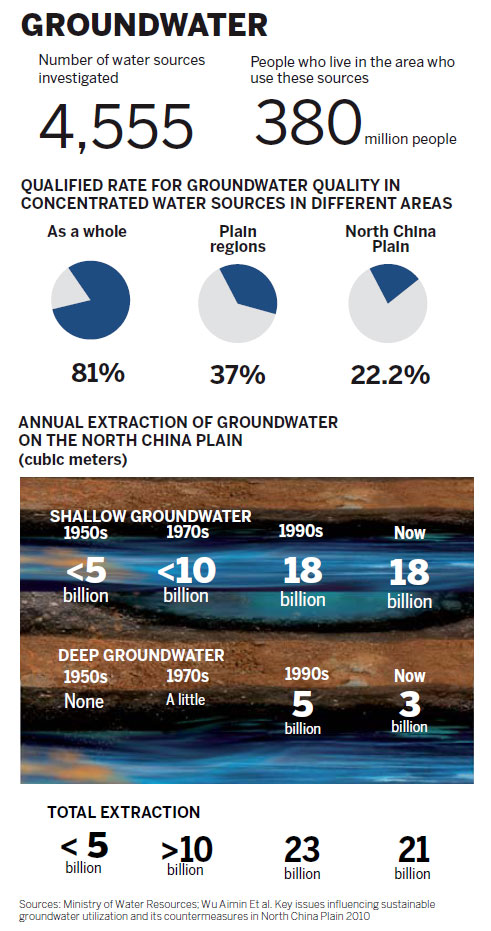A growing thirst for water safety
North China Plain
The problem of polluted groundwater on the North China Plain is exacerbated by the high level of consumption - around 70 percent of the area's total water consumption. The level is much higher than the national average of 17.4 percent, according to a research paper written by Wu Aimin, director of the Geological Survey and Technology Department at the China Institute of Geological Environmental Monitoring, in 2010.
On April 26, the Ministries of Environmental Protection, Water Resources, Land and Resources, and Housing and Urban-Rural Development announced a special investigation proposal targeting groundwater pollution on the North China Plain, two months after heated public discussions prompted by claims of illegal dumping of wastewater in Weifang city.
The proposal highlighted the current condition of groundwater on the plain, pinpointed the main causes and future quality targets.
The key pollutants were identified as heavy metals and organic matter, confirming that some small- and medium-sized enterprises had discharged untreated wastewater into the ground via wells and pits, according to a separate investigation conducted by the Institute of Hydrogeology and Environmental Geology at the Chinese Academy of Geological Sciences in 2006. Zhang Zhaoji, who was in charge of the investigation, refused China Daily's request for an interview.
Chen Ming, from the Water Resources Ministry, explained the reasons behind the intensive investigations in the region.
"It's the most heavily polluted region in China in terms of groundwater. Also, because of China's rapid development, which has constantly affected the environment, investigation into the quality of groundwater may be upgraded and the frequency may be increased. By 2012, there were 41,000 groundwater monitoring stations in China.
He emphasized that the latest round of investigations not only retests water at areas previously visited, but is adding new sites to the list.
However, Gao Cunrong from the China Institute of Geological Environmental Monitoring, said that even with new monitoring stations being built or in the planning stage, there aren't enough of them.
"In a 2004 plan for national geoenvironmental monitoring, we suggested that the country should have at least 55,000 stations. But, the number should be increased to 70,000 to 80,000, because of the country's tremendous economic growth in recent years," said Gao.
The national groundwater monitoring project is planning to build around 15,000 new stations, bringing the total to 56,000 when the project is completed, far below Gao's suggestion.
He urged the central government to build two networks, one regional and the other city-oriented. For example, on the North China Plain measures should be taken to prevent the expansion of land subsidence. Meanwhile, in the cities the government should bore test holes to monitor groundwater in areas where pollution is likely to occur, such as landfills and industrial parks.
Harsher punishments
On June 18, China's top court and procuratorate issued a joint interpretation of the conviction and sentencing standards for criminal cases involving environmental pollution. Under the interpretation, the underground dumping of waste was deemed one of the 14 most serious environmental-pollution offenses with conviction resulting in prison sentences as long as seven years.
Before the interpretation came into effect on June 19, the pollution of surface water was hardly ever regarded as a criminal act, meaning unseen pollution underground was rarely tackled. Punishment was light, too, and in most cases the perpetrators were simply fined.
On May 9, the Environmental Protection Ministry revealed the results of a 40-day investigation into groundwater pollution in six provinces in North China. The ministry advised that 88 out of the nearly 26,000 companies investigated should be fined, but the average fine imposed was less than 70,000 yuan ($11,000).
The only instance of harsher punishment most experts could recall occurred in Yancheng city, Jiangsu province, in 2009. A chemical plant dumped wastewater into a river, polluting the source of drinking water. Supplies to more than 200,000 people were suspended for 66 hours.
The company was accused of "spreading poison" and the two people held responsible for the incident received sentences of 11 years and six years.
Legal experts have been unable to reach a consensus over the sentences handed down in the case, but most agreed that the heavy sentences illustrated the government's determination to impose severe punishments on those convicted of causing polluting, and highlighted its desire to protect the environment.
"The penalty was a little heavy in that case, but the new interpretation issued by the top court and procuratorate indicated the government's resolve to tackle the problem," said Ma Yong, director of the supervision and litigation department at the environmental legal service center of the All-China Environmental Federation.
Outdated standards
Although the laws on the pollution of groundwater are being used to greater effect, many experts and officials are concerned about the outdated quality standards for groundwater.
The 2002 standard outlines a checklist of 109 items to evaluate the quality of surface water used as a source of drinking water, adding 40 items to the version released in 1999.
However, the current quality standard for groundwater, issued in 1993, has just 39 items on its checklist
More than 400 out of China's 660-plus cities obtain their drinking water from groundwater sources, according to statistics released by the Water Resources Ministry, and Chen Ming believes the number of items of the checklist for groundwater drinking sources should be the same as that for surface water.
Ling Jiang, deputy head of the department of pollution prevention and control from the Environmental Protection Ministry, agreed with Chen's suggestion.
"The current number of items is only effective if the area or source hasn't been polluted, but the number of pollutants in the composition of groundwater is already too great and 39 items can't determine the quality accurately," said Ling.
He said the ministry's science, technology and standards department is working on a new version of the quality standard for groundwater, but the issue is still at the expert-discussion stage and far from being implemented.



















